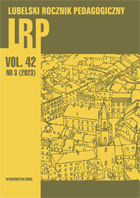NON-EVERYDAY SCHOOL LIFE OF STUDENTS IN GRADES
1–3 DURING THE COVID-19 PANDEMIC. CHILDREN’S
CREATION OF SOCIAL LIFE IN A CRISIS SITUATION
NON-EVERYDAY SCHOOL LIFE OF STUDENTS IN GRADES
1–3 DURING THE COVID-19 PANDEMIC. CHILDREN’S
CREATION OF SOCIAL LIFE IN A CRISIS SITUATION
Author(s): Józefa BałachowiczSubject(s): School education, Health and medicine and law, Sociology of Education, Pedagogy
Published by: Wydawnictwo Naukowe Uniwersytetu Marii Curie-Sklodowskiej
Keywords: pandemic; non-everyday life; remote education; children’s experiences; adaptive characteristics;
Summary/Abstract: Introduction: The crisis brought about by the COVID-19 pandemic has induced numerous changes in the living and developmental environment of children. They have had to recognize and interpret these changes and engage in various new activities to cope with the extraordinary challenges. Research Aim: The aim of this study was to describe and understand how early primary school students experienced changes in the crisis situation within their home environment and remote education, as well as how they adapted to these unusual conditions. Method: The research employed a qualitative approach rooted in the paradigms of social con- structivism and symbolic interactionism. The primary research method used was focused gro- up interviews (focus groups) conducted with groups of students from both first and third gra- des in schools in Warsaw. Results: The results indicate that children experienced social isolation as a strong, multidi- mensional pressure that triggered negative emotions, a sense of confinement, inaction, and emptiness. In response to remote learning at home, they developed new routines, constructed workspaces, asserted their privacy, and valued the nurturing functions of their homes. They perceived remote learning as lacking in personal relationships, agency, a sense of learning, tiring, and dull, which led to their passive participation. Consequently, they expressed re- sistance and creatively sought ways to endure the school time with their peers in the “virtual courtyard”. Conclusions: Analysis of children’s discourse unequivocally reflects a negative assessment of emergency online education. It led to the depersonalization of the child, a sense of invisibility, voicelessness, and passivity during lessons, as well as a lack of personal learning experiences. Children’s reflections and needs should be taken into account in ensuring the effectiveness of digital learning strategies.
Journal: Lubelski Rocznik Pedagogiczny
- Issue Year: 42/2023
- Issue No: 3
- Page Range: 7-23
- Page Count: 17
- Language: English

